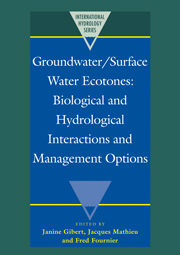Book contents
- Frontmatter
- Contents
- List of authors
- Preface
- I INTRODUCTION
- II FUNCTION OF GROUNDWATER / SURFACE WATER INTERFACES
- 2 Ecotonal animal assemblages; their interest for groundwater studies
- 3 Stochasticity in resource utilization by a larval chironomidae (diptera) community in the bed sediments of a gravel stream
- 4 Temporal and spatial dynamics of meiofaunal assemblages in the hyporheic interstitial of a gravel stream
- 5 Interstitial fauna along an epigean-hypogean gradient in a Rocky Mountain river
- 6 Filter effect of karstic spring ecotones on the population structure of the hypogean amphipod Niphargus virei
- 7 Community respiration in the hyporheic zone of a riffle-pool sequence
- 8 Diversity, connectivity and variability of littoral, surface water ecotones in three side arms of the Szigetköz region (Danube, Hungary)
- 9 Seasonal dynamics and storage of particulate organic matter within bed sediment of three streams with contrasted riparian vegetation and morphology
- 10 Bedsediments: Protein and POM content (RITRODAT-Lunz study area, Austria)
- 11 Dynamics and vertical distribution of particulate organic matter in river bed sediments (Morava River, Czech Republic)
- 12 Surface water/groundwater/forest alluvial ecosystems: functioning of interfaces. The case of the Rhine floodplain in Alsace (France)
- 13 Modelling of hydrological processes in a floodplain wetland
- 14 Contribution to the groundwater hydrology of the Amboseli ecosystem, Kenya
- 15 The role of hydrology in defining a groundwater ecosystem
- 16 Typology of water transport and chemical reactions in groundwater/lake ecotones
- 17 Development of a water transfer equation for a groundwater/surface water interface and use of it to forecast floods in the Yanghe Reservoir Basin
- 18 Uses and limitations of ground penetrating RADAR in two riparian systems
- III MALFUNCTION OF GROUNDWATER / SURFACE WATER INTERFACES: CAUSES AND METHODS OF EVALUATION
- IV MANAGEMENT AND RESTORATION OF GROUNDWATER / SURFACE WATER INTERFACES
- V CONCLUSION
- ANNEX
18 - Uses and limitations of ground penetrating RADAR in two riparian systems
Published online by Cambridge University Press: 07 September 2010
- Frontmatter
- Contents
- List of authors
- Preface
- I INTRODUCTION
- II FUNCTION OF GROUNDWATER / SURFACE WATER INTERFACES
- 2 Ecotonal animal assemblages; their interest for groundwater studies
- 3 Stochasticity in resource utilization by a larval chironomidae (diptera) community in the bed sediments of a gravel stream
- 4 Temporal and spatial dynamics of meiofaunal assemblages in the hyporheic interstitial of a gravel stream
- 5 Interstitial fauna along an epigean-hypogean gradient in a Rocky Mountain river
- 6 Filter effect of karstic spring ecotones on the population structure of the hypogean amphipod Niphargus virei
- 7 Community respiration in the hyporheic zone of a riffle-pool sequence
- 8 Diversity, connectivity and variability of littoral, surface water ecotones in three side arms of the Szigetköz region (Danube, Hungary)
- 9 Seasonal dynamics and storage of particulate organic matter within bed sediment of three streams with contrasted riparian vegetation and morphology
- 10 Bedsediments: Protein and POM content (RITRODAT-Lunz study area, Austria)
- 11 Dynamics and vertical distribution of particulate organic matter in river bed sediments (Morava River, Czech Republic)
- 12 Surface water/groundwater/forest alluvial ecosystems: functioning of interfaces. The case of the Rhine floodplain in Alsace (France)
- 13 Modelling of hydrological processes in a floodplain wetland
- 14 Contribution to the groundwater hydrology of the Amboseli ecosystem, Kenya
- 15 The role of hydrology in defining a groundwater ecosystem
- 16 Typology of water transport and chemical reactions in groundwater/lake ecotones
- 17 Development of a water transfer equation for a groundwater/surface water interface and use of it to forecast floods in the Yanghe Reservoir Basin
- 18 Uses and limitations of ground penetrating RADAR in two riparian systems
- III MALFUNCTION OF GROUNDWATER / SURFACE WATER INTERFACES: CAUSES AND METHODS OF EVALUATION
- IV MANAGEMENT AND RESTORATION OF GROUNDWATER / SURFACE WATER INTERFACES
- V CONCLUSION
- ANNEX
Summary
ABSTRACT Ground penetrating RADAR was used in an attempt to map sediment accumulation in active and abandoned beaver {Castor canadensis) ponds in northern Minnesota and to map buried paleochannels of the Flathead River floodplain in Montana. We attempted to map ice thickness, water depth, sediment depth, depth to parent material (bedrock or clay), thickness of soil horizons, organic deposits (peat), frost penetration, and depth to the water table in the beaver ponds. Ground penetrating RADAR successfully located some of the subsurface interfaces between these layers but water saturation and the high clay content of the soils interfered with the ground penetrating RADAR signal while the physical complexity of the subsurface hampered data interpretation. In Montana, paleochannels and water tables were located, but the stony nature of the substrate prevented immediate excavation for verification. In both Montana and Minnesota, success depended strongly on physical characteristics of the sites and specific interfaces. Generally, our efforts were only successful where the physical subsurface interfaces had abrupt, well defined boundaries, and where clay content was low.
INTRODUCTION
Ecological applications of ground penetrating RADAR (GPR) have included classification of soils and remote examination of their structure (Doolittle, 1982; Ulriksen, 1982).
- Type
- Chapter
- Information
- Groundwater/Surface Water EcotonesBiological and Hydrological Interactions and Management Options, pp. 140 - 148Publisher: Cambridge University PressPrint publication year: 1997
- 10
- Cited by

